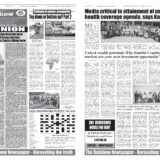Fertilizer Subsidies—Which Way Forward?
Notice: Undefined index: catFilterList in /home/zambi/public_html/wp-content/plugins/wp-likes/api.php on line 243
An IFDC/FAI Report
Edited by Jikun Huang, Ashok Gulati, and Ian Gregory
February
2017
i
Preface
Fertilizer subsidies in developing countries have been increasingly common policy interventions
in recent years to increase supply and use of fertilizer and thus stimulate agricultural output and
farmer i
ncome. The volatility of global food and fertilizer prices in 2007 and 2008 provided a
stimulus for this resurgence in fertilizer subsidies. The multiple objectives and the rapid growth
in the financial burden of subsidies and their share of the total support to agriculture have
brought into question whether fertilizer subsidies are an appropriate policy intervention to meet
the challenges of feeding almost 10
billion people in 2050,
1
increasing urbanization in
developing countries, reducing rural poverty, and reducing
environmental impacts on regional
agricultural production.
Balanced and efficient fertilizer use is an essential component of increased agricultural
production together with improved crop varieties, water management, land preparation, weed,
disease and insect control
, and sustained soil health. Harvesting and post-
harvest technologies
are also essential to capture and preserve increased agricultural production. The economic use of
fertilizer is dependent upon the ratio of fertilizer price to crop output price and the incremental
crop response to fertilizer nutrients. Fertilizer subsidies are merely transaction subsidies that
impact the input/output price relationships. However, the whole supply and output value chains
related to agricultural production include a multitude of services that impact fertilizer demand
and use from finance to technical to processing and markets. In developed economies, fertilizer
subsidies have essentially disappeared
2
and agricultural support programs, particularly crop price
stabilization,
crop insurance programs, area payments uncoupled from production, and support
linked to environmental criteria
, replaced input subsidies in the 1960s and 1970s.
The Fertiliser Association of India (FAI) and the International Fert
ilizer Development Center
(IFDC) jointly undertook an analysis of fertilizer subsidies in five Asian countries (
Bangladesh,
China, India, Indonesia
, and
Pakistan) and four s
ub
-Saharan countries (
Malawi, Nigeria,
Rwanda, and
Tanzania) to understand their impact on the countries’ fiscal budgets, on
1
United Nations Population Fund forecast, 2015.
2
http://www.oecd.org/tad/agricultural-
policies/support
-policies
-fertilisers
-biofuels.htm
ii
productivity and nutrient management, and on the efficiency of fertilizer production, distribution,
and consumption. Such analysis is intended to assist policymakers interested in better
understanding the impact of fertilizer subsidies by documenting the diversity and effectiveness of
existing subsidy programs and drawing lessons from the different regimes.
The selection of the five Asian countries reflects the different sizes of the domestic fertilizer
markets
—fro
m the world’s largest and second largest fertilizer nutrient markets (China and India
with 2
8.8% and 13.5%, respectively
, of the global fertilizer nutrient consumption in 2012/13) to
smaller Asian markets
(Bangladesh with 1.1%, Pakistan with 2.3%, and
Indo
nesia with 2.9%)
and a geographically challenging farm distribution. All of these countries participated in the
“Green Revolution” from 1950 to 1970 and now have a long history of fertilizer use and
fertilizer subsidy support, which were integral components of the Green Revolution. The
selection also represents different levels of domestic fertilizer production and imported fertilizer
dependence and the top five Asian countries with fertilizer subsidies
.
Sub-
Saharan Africa
(SS
A)
, in total, only accounted for 1.6% of global fertilizer nutrient
consumption in 2012/13,
and national markets are still very small. The selection includes the
largest SSA fertilizer market (Nigeria in West Africa) and three markets in East Africa
, of wh
ich
two (Rwanda and Malawi) are landlocked countries that incur substantial inland freight costs for
imported fertilizer. None of the SSA countries benefited from the Asian Green Revolution.
The world fertilizer market is increasingly globalized
, with tra
de in 2012/13 accounting for
31.8% (N
), 36.3% (
P), and
82.1% (K) of total consumption, and reach
ing
181.62 million metric
tons (Mt) of nutrients (
N+P
2
O
5
+K
2
O) in 2012/13, a 30.7% increase from 2000/01.
3
In the two
years from 2007 to 2009, total world consumption of nutrients fell by 25.5% to 54.96 Mt
due to
the financial crisis, economic downturn, and high volatility of
international prices for fertilizers
and agricultural commodities
. It
subsequently rebounded to 181.62 Mt
by 2012/13. In 2012/13,
the aggregate world demand was 110.17 Mt
for N, 41.1 Mt
for P
2
O
5
, and 30.37 Mt
for K
2
O.
3
http://ifadata.fertilizer.org/ucSearch.aspx
iii
East Asian fertilizer consumption rose firmly between 2000/01 and 2012/13, and consumption of
N only fell marginally in 2007/0
8, while that of P and K declined by 11.9% and 30.8%,
respectively
, in that year.
South Asian demand also expanded firmly from 2000/01 to 2012/13, and contrary to most
regions, regional demand soared during the crisis period from 2007/08 to 2008/09, boosted by
demand in India where farmers were protected from international price increases. Conversely,
regional demand contracted in 2011/12 following revisions to India’s fertilizer subsidy regime.
In SSA
, after a depressed period of more than two decades following the structural adjustment
progra
ms that
removed national fertilizer subsidy programs
, fertilizer demand has gained
momentum since 2009, albeit from a very low base. Regional consumption of fertilizer nutrients
is estimated to have increased by 47% between 2000/01 and 2012/13, mainly due to increased N
consumption. The region was slightly
affected by the downturn in 2008/09.
It is estimated by the International Fertilizer Association (
IFA
)
4
that aggregate fertilizer
consumption of the countries subsidizing fertilizers accounts for 54% of world fertilizer demand.
The nine countries considered in this analysis represent 41% of world fertiliz
er demand
, or
almost 80% of subsidized fertilizer. Not all the fertilizer consumption in these countries is
subsidized, but they represent a major portion of the global fertilizer subsidy scene.
Slightly over 50% of global fertilizer use in 2010/11 was estimated to be on cereal crops with the
three main cereals, wheat, rice, and maize, each accounting for between 14% and 16% of the
world total use.
5
There is considerable variation in use by crop between regions. Cereals account
for 44% in East Asia, 51% in South Asia, and possibly 60% in SSA.
6
The importance of
fertilizer use on cereal crops, the main staple food source for much of the developing world, is a
major reason why fertilizer subsidies have been used in attempts to increase food production and
food security. Initial design of fertilizer subsidies generally involved pan-
territorial pricing,
4
See Chap
. 2 of this paper
.
5
Heffer P (
2013
) Assessment of fertilizer use by crop at the global level, 2010
-2010/11. IFA
, Paris.
6
FAO; World Development Indicators (3) Cereal Yields.





















